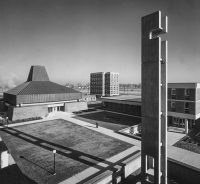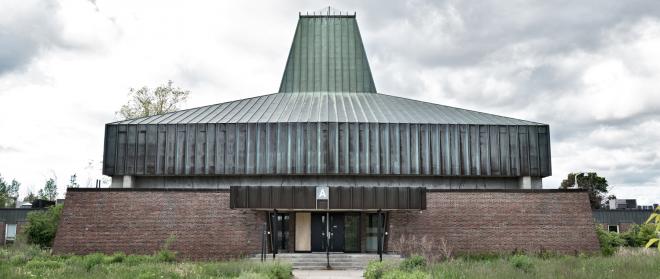
OTTAWA MAGAZINE, By Lisa Gregoire
Tim Murray carefully climbs the stairs in an abandoned church he designed more than 50 years ago on what were, in the 1960s, farm fields on the outskirts of Ottawa. The church was the centrepiece of Murray’s largest commission to date — a convent and education centre on Heron Road that included a dozen interconnected buildings situated around a series of courtyards.
The church had to be modern, full of light, and functional, he says. He talks about the quality New England clay bricks he had convinced the nuns to purchase after a trip they all made to Boston to share a lesson in architecture.
We arrive at the musty main entrance where the centre aisle of the sanctuary would have been. The late Gerald Trottier’s exquisite bronze sculpture still hangs beneath the sky-lit apex. Trottier called it "Manna From Heaven" or, as Murray explained, “blessings coming down.” [The sculpture] is surrounded by a pyramidal concrete enclosure poured continuously, on Murray’s direction, for about 36 hours. Along the right and left walls are lattice-brick corridors Murray designed so that nuns late for mass could slip silently from their private quarters and enter from the back of the church, unheralded.
The perimeter of the roof once had a glass soffit that collected rainwater; as light passed through, it would reflect through the glass above and shine inside the church. It was one of Murray’s favourite design elements.
“The angle of incidence equals the angle of reflection,” he says. If the breeze moved the water, the light would dance on the ceiling opposite, a mysterious natural phenomenon you could never predict. But the soffit is full of stones now, and a wide second-floor mezzanine — added by the new owners years later to increase seating capacity — obscures most of the natural light and makes the place feel gloomy.
“If you live long enough, you see what happens to some buildings that you’ve done,” says Murray, who, with his late brother Patrick, launched an architectural dynasty in Ottawa with Murray and Murray Associates. “It rooted something in us.”
Designed in 1963 for the Sisters of the Congregation de Notre Dame (CND), a religious order founded in 1658, and built by M. Sullivan and Son of Arnprior, the distinctive, copper-sombrero-roofed church is part of a 21-acre campus on Heron Road, just east of Alta Vista Drive. It cost about $4 million in the 1960s and included Catholic high schools for girls and boys, residences for nuns and novitiates (nuns in training), as well as a theatre, gymnasium, and cafeteria, all connected by glassed walkways and underground tunnels. The nuns honoured Murray by calling the place “Campanile” for the belfry in the central courtyard.
Campanile replaced the 19th-century convent and boarding school on Gloucester Street that the sisters had occupied for nearly 100 years. Campanile was a modern, purpose-built space for learning, worship, and meditation. But Ontario didn’t yet fund Grades 11 to 13 in Catholic schools, and private tuitions had to cover the many lay teachers’ salaries, as well as convent operations. And it was the 1960s: fewer women were becoming nuns. By all accounts, money was tight. Only eight years after they moved in, the sisters sold it. Murray was devastated when he heard. “It was so sad. They loved it.”
During a period of infrastructure expansion in the mid-1970s, the federal government bought the campus, and for the next 40 years, Campanile was known as the Federal Study Centre. The Canadian Emergency Management College ran courses there until 2012 when the feds declared it surplus. It has been vacant ever since, except for a small part used by St. Patrick’s Intermediate School next door. It will soon be in the hands of the Canada Lands Corporation, which plans to sell it.
Murray was 33 when he designed the campus. He would later design commercial and institutional buildings around the world as well as in Ottawa — the Elgin Street courthouse, and buildings at Carleton and Ottawa universities. At one time, he and his brother employed more than 80 people in Canada, Africa, and Britain. Murray worked until he was 75. He travelled the world and loved what he did because, he says, clients of architects are full of optimism and ideas.
In 2005, the Federal Heritage Buildings Review Office formally recognized the Federal Study Centre for its “architectural and environmental values.”
The “heritage characteristics of the buildings must be considered as part of any proposed redevelopment,” notes Public Services and Procurement Canada. Time will tell who shows an interest and what the City of Ottawa allows.
This article has been condensed for brevity. The complete article and photo essay is available at Ottawa Magazine.
Related Reading:
Federal Study Centre to be Transferred to Canada Lands / Heritage Ottawa, January 22, 2015
